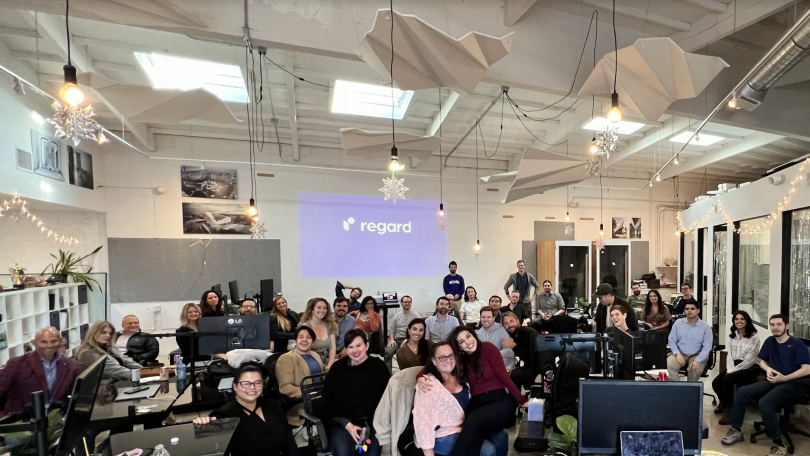During a recent “jam week” (when employees fly out to co-work in person) at the Los Angeles headquarters of healthtech company Regard, team members were sifting through a deck of conversation cards when the topic turned to company values.
The prompt was, “What are some of our unspoken values?” An engineer ventured the suggestion: “Community, quality and improvement.”
“He said he felt like this is a culture where nobody has an ego. Everybody feels very strongly that they want to be the best possible person and make the best possible product — and because of that, we’re constantly working to improve,” recalled Senior People Experience Manager Bita Masjedi.
The reaction?
“Our CEO looked at him and was like, ‘I think those are our new values. We're going to roll some of our old ones into it, but that speaks to it so well,’” Masjedi said. “Everybody just kind of had a moment of, ‘Wow, that’s it.’”

All of those values — community, quality and improvement — complement one another and are germane to the healthcare field, which the company serves. But as three team members at Regard — which announced a $15.3 million Series A in June 2022 — explained in a recent interview, the “improvement” value in particular is emblematic of the symbiotic relationship between a feedback-rich internal culture and a customer-voice-driven approach to product.
Team members are quick to stress that while it has been recently made more explicit, an emphasis on improvement has been integral to the company since its launch. This focus is seen in the evolution of the product, as the company is committed to continuously investing in improving the Regard solution to delivery the highest quality possible, according to Lead Designer Tiffany Estrella.
“We continuously learn, improve and change. It’s never-ending,” Estrella said.
“We continuously learn, improve and change. It’s never-ending.”
VP of Clinical Operations Francisco Alvarez, M.D., added that direct engagement with the user — clinicians who integrate Regard’s system with their electronic medical records — is critical to improvement, and is championed from the top-down.
“Leadership has been keen on making sure that everyone, no matter their role, has the opportunity to go onsite to hospitals to actually see people use our system,” Alvarez said. “It is one thing to be an engineer working in the code base, seeing these tickets come in and reading the user feedback reports. It’s another thing to go into the hospital and see a doctor using the software that you have been designing and building, and hear their response to it.”
As team members conveyed, the “improvement” value is a framework through which to pursue their respective crafts — and, in the process, further the product and the experience of using Regard.
“Because it’s OK for us to talk about our limitations or areas for improvement as people, we are very comfortable calling that out in our product. And no one takes offense if they worked on a part of the product that’s not performing as expected,” Masjedi said. “Removing that feeling of having to project perfection — because you need that for job security — has let us have a very high-impact product. We are OK saying we made an error; ultimately, we all care most about the end result, which is that it’s performing well for our users.”
Chatting with Built In, the colleagues unpacked how the mutually complementary emphasis on improvement pays dividends — both internally and externally.
What Regard Does
“It’s an AI-empowered copilot that helps doctors find missed diagnosis and eliminates a lot of the burden that they have around charting so that they can free up more time to be with patients,” Masjedi said of Regard’s system. Estrella added, “We help doctors find missed diagnosis and document better, which helps with revenue because we are more accurately able to bill with improved medical notes.”
To start, how does that value of improvement play out in the workplace?
Lead Designer Tiffany Estrella: It’s about a growth mindset. We improve on an individual level as well as on the product level. We’re always listening to our users; we want to make sure we’re easing any pain points that they may have.
VP of Clinical Operations Francisco Alvarez: I’m a physician, and I’ve worked in healthcare for quite a few years. In general, healthcare is not a fast-moving field. There’s not an expectation of a quick turnaround. One thing that we hear again and again from our users is, “I said there was an issue and you fixed it immediately.” We are not only making a great product that people will love, but we respond quickly and show them that we care and are listening to them.
How are you able to act on feedback quickly?
Estrella: It’s definitely cultural: Our users drive our product. If there is a problem, it can be a life-or-death issue. We need to make sure that we get to that right away. Providing the best product possible means that they can do their job better.
“If there is a problem, it can be a life-or-death issue. We need to make sure we get to that right away.”
Alvarez: We’ve worked very hard to reconceptualize and fine-tune the workflow so that we always have someone paying attention to user feedback and getting it seen by the right person — whether it’s an engineer for a technical reason or a physician who needs to review for clinical reason. In our software, there’s a user feedback button that you can click on anytime and write whatever you want. Within that, there’s a box that says, “Inform me of updates;” if they select that, we will message them back almost immediately, saying, “We got your user feedback. Here’s our immediate thoughts, here’s what we're doing about it.”
Aside from product improvements, what do you think Regard does well to encourage team members to improve themselves?
Senior People Experience Manager Bita Masjedi: We have a very open feedback culture. As long as the feedback you’re providing is fair, constructive and backed up with facts, we encourage you to share it regularly and directly with team members, regardless of their role or level at the company.
And team members don’t just take feedback, you’ll see them take action on it.
For example: We’re about to roll out our 360 reviews and we wanted to make a sample review with examples to guide new team members on how to give helpful and constructive feedback to their peers. We pulled out actual feedback employees had received from previous reviews and put it in our template. When we reached out to the employees to make sure they were comfortable having their feedback put out there, every single one said something like, “Totally. That was so helpful for me. It really leveled me up as an employee, I can see how it could be helpful to share with others.” This showed how feedback-driven our culture is, and how team members truly implement that feedback.
Also, just as we constantly solicit feedback from our users, we do the same from our employees. An example of this is our onboarding survey, which we send out after a new hire’s first week. If a new hire responds with, “This was great, but if this was done, it would have been better,” we try to implement their suggestion before the next onboarding session.
We have two review cycles a year; the mid-year one is top-down and the end-of-year one is a 360 review. These reviews, tied together with our feedback surveys, have built out a strong culture of people wanting to do their best, receive feedback on how they can be better and then help others around them also level up.
How do you feel like your own improvement is supported in the day-to-day workplace at Regard?
Alvarez: The company really pushes you to grow as a person and a professional and also recognizes that, as part of that growth, there are going to be things you are learning and that’s OK. We do weekly check-ins in which our CEO is very open about his own learnings. That transparency is true for everyone on the team.
Masjedi: We’ve adopted this idea of asking people if they are receptive to feedback — don’t walk in and tell someone, “This is what you can do better.” Instead, say, “Coming out of that meeting, I have some feedback for you. Are you open to receiving it? Is this a good time for you?” We also encourage our employees to understand that receiving feedback is a gift and giving it is just as hard as receiving it. Because of that, go into it with an open mind, and it’s OK to reply with something like, “Thank you for that, I need a little bit of time to digest that before I can take action on it.”
“We also encourage our employees to understand that receiving feedback is a gift and giving it is just as hard as receiving it.”
Estrella: We have a culture of learning from each other. There are lunch-and-learn sessions where we’ll learn what every person is working on. When someone joins the team, they’re encouraged to have coffee chats with others. We encourage people to be curious and ask questions from any part of the organization. We’re completely open with each other about what we do.
Looking ahead, how do you individually hope to continue improving at Regard and, by extension, help improve the product itself?
Masjedi: I want to get to the point where I’m constantly thinking of new and interesting ways to make sure employees are having the best experience. If you love where you work, then you are going to put your passion into the product.
Alvarez: For me, it’s about how we can leverage what we’ve already built and improve upon that to make doctors’ and nurses’ lives better — that then cascades down to improving patient care and patient experience. What can we do to take things further, not be complacent about the feedback and the success we’ve had and make healthcare better for both workers and patients?
Estrella: It’s about digging in and finding where all the improvements can be made and continuing to be curious. Beyond the scope of what we’re doing, how else can we help different areas? These core values have always existed. Now they’re just in writing. As we grow, we make sure that everyone that comes onto the team is imbued with those core values as well.








